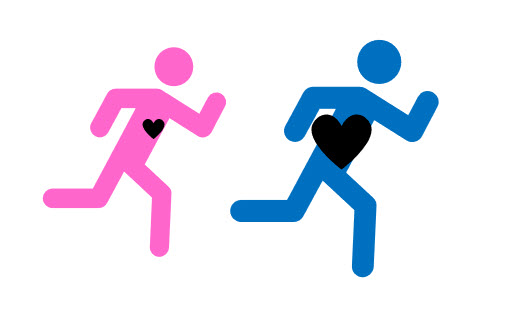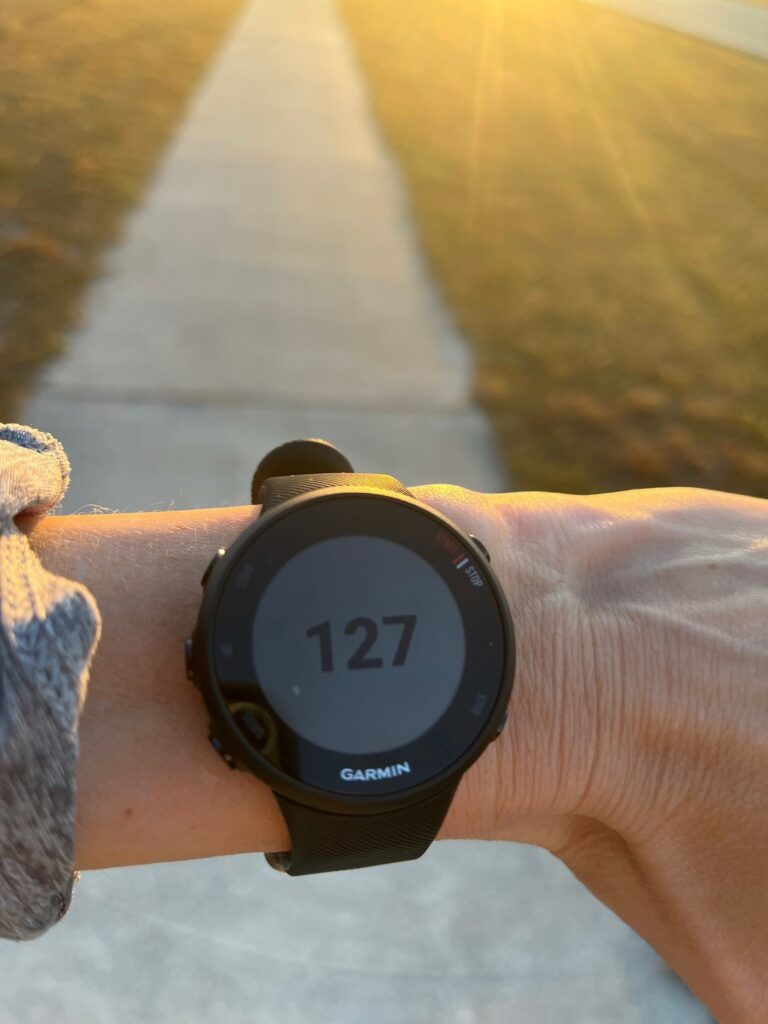
As more and more women get serious about exercise, running, and tracking heart rates there are a few things to know. Most of us, including myself, have used the one size fits all calculation for estimating max heart rate based on age, but the differences in gender heart rates may surprise you, as it did me.
Studies have shown there are important gender differences in heart rates which traditional heart rate calculations do not reflect. As a result, women using a heart rate monitor may not be exercising in the desired heart rate zone. In addition, realizing there are differences impacts what may be considered a normal or abnormal response to exercise.
More and more women are using heart rate monitors to track exercise and running workouts. The benefits are numerous, but only if you are using and comparing accurate data. Studies have found that male and female heart rates do differ, and these differences can really add up when you exercise. Read on for some valuable information women need to know and how you can benefit by understanding these differences.
Factors that impact gender differences in heart rates

There are significant differences between men and women such as body mass, hormones, and genetics. All these factors have been found in studies to affect average heart rates and heart function during exercise between the sexes.
While some of the differences are obvious such as body size, muscle mass, and bone mass other factors such as estrogen and testosterone levels may play a larger role than previously thought. Regardless of the reasons for the observed differences, being aware of how heart rates differ is important for women in making better decisions about their health and when exercising.
8 ways female heart rates differ from males
- Women have lower max heart rates than males of the same age. Based on this finding updated calculations result in estimated max heart rates being lower for women compared to men.
- The traditional max heart rate HRmax formula (220- age) still widely used overestimate max heart rates for most women, especially older women (see study here).
- Both male and female peak heart rates decline with age, but the decline is more gradual in women (see study here).
- Women have a higher resting heart rate than men. The average adult male heart rate is between 70 and 72 beats per minute, while the average for adult women is between 78 and 82 beats (see study here).
- Women’s heart rates don’t rise as dramatically during exercise as men’s and return to normal more slowly after stopping. (See study here).
- Women have smaller hearts than men. On average, women have ¼ smaller hearts than men (see study here).
- Women tend to have better heart function than men before menopause. After menopause there is not much difference indicating that the estrogen hormone may play a role in heart function (see study here).
- Maximum oxygen consumption (VO2max) is lower if females compared to males in traditional whole-body systemic exercise. Differences are still present after correcting for differences in fat and muscle mass (see study here).
Why does knowing female heart rates differ from men’s matter?

There are some important reasons for knowing women’s heart rates differ from men’s when exercising. One can potentially have serious implications for your health while the others can impact your exercise performance and weight loss goals.
In general, standard heart rate charts and calculations do not provide accurate data for women to use when exercising. Many of the charts and calculations are based on data collected mainly on men several decades ago. They do not reflect the more recent studies and data collected on how women heart rates perform during exercise leading to three main issues.
Three main problems of inaccurate female heart rate calculations
- Women may not be able to tell what a normal or abnormal heart rate is when exercising. Assuming they are within “average” limits based on male averages, women may not have important information signaling there may be health issues and to seek proper medical attention. In addition, they can have inaccurate heart rate recovery figures which are an important metric of overall health and cardiac fitness (see my article here for more on the benefits and how to calculate it).
- Women may not be optimizing their workouts by exercising in the desired target heart rate zone. While it may not matter for easier workouts, when training with HIIT workouts, threshold runs and tempo sessions, the differences can really add up (see my article here for amazing benefits of HIIT training).
- Women may not be getting the maximum benefit of exercise for weight loss and fat-burning goals. Exercising at moderate to vigorous intensity is ideal for such goals. There is also the danger of injury, fatigue, and burnout by continuing to train at higher-intensity levels for longer than planned which can derail your fitness goals.
The traditional max heart rate calculation is flawed

Heart rate calculations are flawed especially when it comes to women. They may be convenient for quickly getting a max heart rate, but they have some serious shortcomings that go beyond just being estimates.
Most calculations are based on predominately male heart rates. The most widely used method is called HRmax and is simply 220 – Age. This calculation was developed over 40 years ago and is based on a male standard.
It wasn’t until 2005 that the studies were able to finally determine normal heart rates for women. The Gulati formula below was the calculation designed for women based on that study. Since then, other studies have been done resulting in similar female-targeted calculations (click here for the study).
The below chart compares the different calculations for quick analysis. The Mayo Clinic does advise that individual max heart rates may vary by 15-20 beats.
| Age | ||||||||||||
| Source | Formula | 20 | 25 | 30 | 35 | 40 | 45 | 50 | 55 | 60 | 65 | 70 |
| HRmax (Traditional) | 220 – Age | 200 | 195 | 190 | 185 | 180 | 175 | 170 | 165 | 160 | 155 | 150 |
| Unisex Hunt Fitness Study | 211- (Age x 64%) | 198 | 195 | 192 | 189 | 185 | 182 | 179 | 176 | 173 | 169 | 166 |
| Men (acc.org) | 216-(Age x 93%) | 197 | 193 | 188 | 183 | 179 | 174 | 170 | 165 | 160 | 156 | 151 |
| Women over 40 (acc.org) | 200-(Age x 67%) | 173 | 170 | 167 | 163 | 160 | 156 | 153 | ||||
| Gulati’s for women | 206 – (Age x 88%) | 188 | 184 | 180 | 175 | 171 | 166 | 162 | 158 | 153 | 149 | 144 |
The most accurate way to calculate the female heart rate

For the most accurate max heart rate you should have a stress test performed in a lab with medical personnel. This is traditionally done for those with cardiac issues, but it is the safest and most reliable way to get your max heart rate.
You can also simulate a stress test by performing a field test with a heart rate monitor. This should not be done if you have any heart issues or underlying health issues.
There are many variations of a field test that can be used. They all involve gradually increasing the intensity of the workout until you are at maximum effort for a period of time. See my article here for more information on an example of a field test to perform and heart rate monitors that can be used.
What if my heart rate falls above or below the calculations?

Heart rates that are above or below the estimated max heart rate calculations could indicate there is a problem. It is recommended that you get checked out by a doctor or cardiologist to ensure your heart is functioning properly.
Heart rates that are higher than the average could be a sign of tachycardia. Some conditions are mild while others can be life-threatening, so it is always best to consult your doctor. This condition is usually associated with a high resting heart so be sure to track that metric as well.
High max heart rate and resting heart rate can also be a sign of overtraining. It is possible to exceed your max heart rate and doing so puts additional strain on your heart and body. If at any time you feel dizzy or nauseous, seek medical attention right away.
Medication can also affect your max heart rate. As an example, medications to lower blood pressure may cause a lower max heart rate. As a result, your training zones will need to be adjusted to exercise safely. Always be sure to check with your doctor about any new exercise programs and recommended training zones.
It could be that your heart rate is normal, and you have healthy heart function. Everyone’s heart rate is different and is influenced by genes, diet, habits, body composition, and more. The calculations are only estimates that are based on averages so some people may be higher and others lower.
There are other heart rate metrics you may want to track when exercising. Your heart rate recovery, or how fast your heart returns to normal, is an important indicator of fitness and heart health. Be sure to track your resting heart rate and heart rate recovery for getting a better picture of your cardiac fitness (see article here for more information on heart rate recovery).
Key Takeaways
There are important differences between female and male heart rates that women should be aware of. These differences can impact exercise performance, weight-loss goals, and more.
While everyone’s heart rate is unique, having the most accurate data for comparison purposes can keep you safe, optimize your workouts, and help you get the most out of your heart rate training.